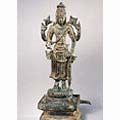 |
|
 |
 |
 |
 |
 |
 |
 |
 |
Sculptures from South India, 8th-9th Centuries
Most of the sculptures and monuments in south India that date from the 7th through the 9th centuries are associated with one of the two most important dynasties during this period, the Pallavas and the Pandyas, both of which were Hindu. The Pallavas can be traced back as far as the 2nd century C.E., although it is not until the second half of the 6th century that the family and its history emerge more clearly due to inscriptions and monuments carved in stone. Their rule centered on the eastern coastline around the cities of Kanchipuram and Mamallapuram, the latter being the site of the famous carved-stone cliff created by Pallava kings in the 7th century. The Pandyas, about whom little is known, centered their rule further south in the vicinity of Madurai. Like the Pallavas, the Pandyas employed the rock-cut medium in addition to building brick and wooden temples. The large Seated Woman in the Asia Society's collection is an example of this type of work. |
 |
 |
| 1 thru 3 of 3 |
 |
| view text only list |
 |

Seated Woman |
 |

Vishnu |
 |

Woman |
 |
|
 |